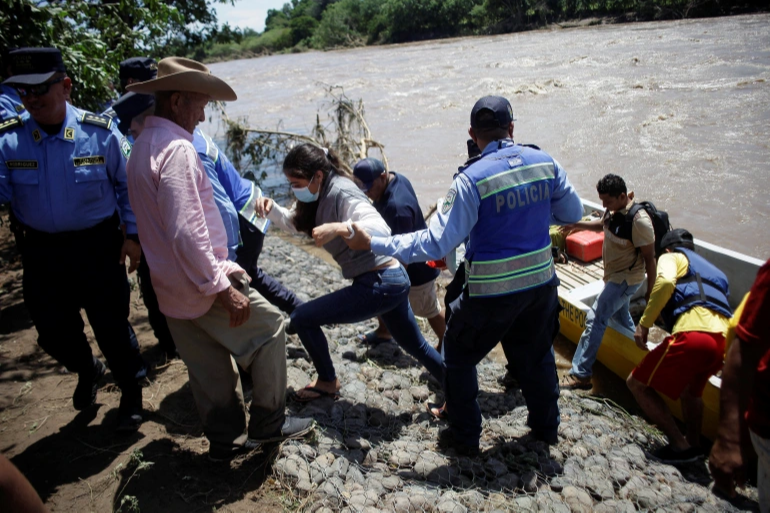
Police officers help a woman in the aftermath of storm Julia in the department of Valle, Honduras, October 11, 2022 [Fredy Rodriguez/Reuters]
San Pedro Sula, October 19 (RHC)-- Nearly two years after hurricanes Eta and Iota pummelled northern Honduras, flooding entire neighbourhoods and causing widespread devastation, 40-year-old Marlen Oliva has fled her home again this month as Hurricane Julia swept through.
Oliva, who sought refuge at a government shelter in San Pedro Sula, said her family was still struggling to recover from the financial hit of the previous storms when Julia arrived. To support their five children, Oliva and her construction-worker husband had attempted to migrate to the United States last year, but they were deported after reaching southern Mexico.
“Things are just getting worse,” Oliva told Al Jazeera, referencing the country’s economic situation and its vulnerability to natural disasters. “With this situation, what you do is migrate.” They were among hundreds of thousands of Central Americans estimated to have attempted to migrate north after the deadly 2020 hurricanes. Border officers encountered more than 319,000 Hondurans trying to cross into the US in 2021, about a fifth more than pre-pandemic figures. That data does not include people such as Oliva, who did not even make it that far.
According to the Red Cross, more than 1.5 million people were displaced in Central America after Eta and Iota, with almost a third of those hailing from Honduras. Now, with hurricane season again in full swing, aid groups and local leaders worry that another migration crisis is brewing.
“Even though two years have passed since [Eta and Iota], many people have still not recovered from the disastrous impacts that the floods provoked,” Cesar Ramos, who works with the Mennonite Social Action Commission migrant support programme in Honduras, told Al Jazeera. “If the authorities don’t provide immediate, timely care and consider this truly as an emergency, then people will find themselves having to migrate,” he said. “The truth is that people can’t wait.”
Hurricane Julia, which made landfall in Nicaragua on October 9, affected more than 100,000 Hondurans, according to government estimates. Thousands fled to government shelters, while others sought refuge in churches, or with family or friends.
With waters knee-high, some communities were isolated for days, their roads impassable. Losses of banana, corn and African palm crops were estimated to have cost the Honduran economy millions of dollars.
While Julia, as a Category 1 hurricane, was relatively weak compared with past storms that have hit the region, Honduran communities in the Sula Valley are particularly vulnerable due to their proximity to rivers, such as the Ulua and Chamelecon.

